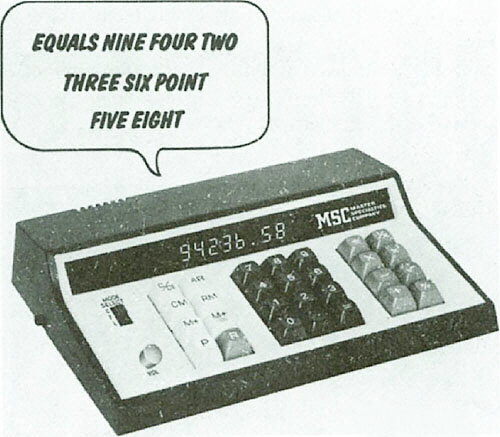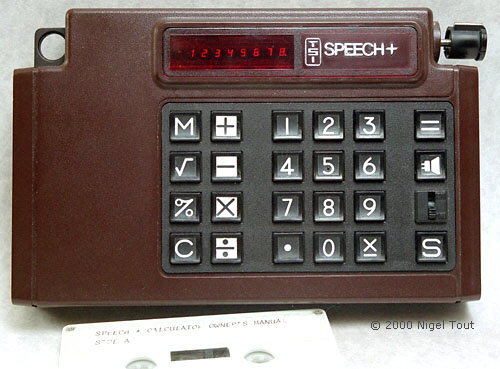



Calculators for the Blind
© 2021 Nigel Tout
This is a new article which was not originally in "The International Calculator Collector".
In the early 1970s, with the advances in electronics, there was considerable effort to produce a calculator for use by the blind, either by using sound or Braille output.
An early attempt was recorded in the journal 'New Scientist' in October 1973 in the report of a meeting of the British Computer Association of the Blind (BCAB) in Reading[UK.][1]:
"
New devices help scientists read and add ...
Another device on display at Reading was a desk calculator developed by the Clarendon Lab of Oxford University which
gives results aurally. It uses tones for numbers: a long low for one, a long low plus a short for two, a long low plus two shorts for three, up to five which is a high long, then six is a high long plus a high short,
etc. The decimal is indicated by a click. Twelve units are being built for the Royal National Institute for the Blind (RNIB), and in production the unit would probably cost £250 [GBP, about US$600].
Coleman says that 17 labs, including five in England, were working on blind calculators."
Later, in October 1975 the journal 'Electronic Design' reported a commercial talking calculator[2]:
"Calculator vocalizes data entries and results
Master Specialities Co., 1640 Monrovia Ave., Costa Mesa, CA 92627. $595.
MSC's new ARC 9500 audio-response calculator talks to
you with its solid-state natural-sounding synthesized voice. It announces each entry and the results of every calculation in a loud, clear voice, according to the manufacturer. Talking calculators are used in the
vocational education of the blind and in the reinforcement of basic math concepts for sighted students. In addition, sighted users find that it permits them to concentrate full visual attention on the input figures being
entered without having to shift attention back and forth to look at the visual display. The ARC 9500 is an eight-function calculator and also has an eight-digit visual display."

Master Specialities Co. ARC 9500 Audio Response Calculator.
The journal 'Mathematics Teacher' had more information about the Master Specialities Co. ARC 9500 calculator in March 1976[3]:
"A talking calculator
ARC 9500 Audio Response Calculator. Master Specialities Co., 1640 Monrovia, Costa Mesa, CA 92627. $565.
Master Specialities Company is now marketing a desktop
calculator that talks—the ARC 9500 Audio Response Calculator. There is no tape recording involved; the calculator announces each entry and the results of each calculation in a natural-sounding voice coming from a
built-in speaker system. It also has a large visual display, and its vocabulary includes words such as "plus", "minus", "times", "divide", "equals", and "point" (for decimal point).
This calculator
operates in three modes: one for learning, one for fast peration with audio, and one for standard operation without audio unless requested by depressing the repeat key. It is compact (3" by 10" by 7½") and easily transportable. It has, in addition to the four basic functions, keys for memory, square root, percentage and reciprocal, and it operates with eight-digit display in floating decimal
point. Overflow is indicated by a tone. There is volume control for the audio and a jack for external speakers.
This calculator has obvious uses in the vocational training of blind persons, but it
also has a new use for the sighted. For example, the sighted person can concentrate visually on the work or columns of figures without shifting attention back and forth from keyboard to display.
The
price puts it out of the reach of the average individual owner, but schools definitely should investigate this new product, especially if they have programs for blind persons or persons with limited eyesight."
in December 1975 the journal 'Electronic Design' reported on a calculator with Braille output and also a talking calculator from Telesensory Systems Inc.[4]:
"
A talking calculator is new aid for blind
An electronic calculator that displays braille and a calculator that talks have been announced by the American
Foundation for the Blind in New York City.
The braille calculator, developed by the foundation's Engineering Dept., provides results in two modes, one a visible gas discharge display and the other a braille
display. After a readout button is depressed, the digits and decimal points, as displayed on the visual readout, are sequentially translated to a braille cell. The signals are demultiplexed and decoded by ROM and then
multiplexed at a very slow rate and converted to four-dot braille information.
The calculator forms a braille digit be energizing electrical solenoids, forcing small dots or pins to protrude beyond the face of
the braille cell. These are coded to represent the braille notation for each digit displayed. All the braille pins are de-energized momentarily when the calculator sequences to the next digit.
The talking calculators, developed by Telesensory Systems Inc., of Palo Alto, CA, receives inputs from a keyboardand provides answers from a 24-word tape over a self-contained
speaker or an earphone.
As a user pushes a key, the loudspeaker repeats the number. When he pushes the readout button, the calculator reads out the display. the unit is built with a pre-programmed
ROM whose digital format is converted to analog speech through a d/a converter.
The units will be available in February at the American Foundation for the Blind, 15 West 16th St., New York City 10011."

The Telesensory Systems Inc. Speech+ talking calculator with audio cassette holding the operating instructions on cassette.
The knob at top right is pulled to turn the calculator on and then acts as a volume control. Pressing the button with the loudspeaker symbol (below the "=" button) makes the calculator speak the number on the display. The switch below this button can be used to switch off the speech system.
An interesting feature is that, to aid the blind in using it, the numbers on the keypad are in the same order as a phone (with 1 at the top) rather than the normal order for a calculator (with 9 at the top).
The cost of the TSI Speech+ in 1976 was US$395[5]. This was the first commercial hand-held speaking calculator and a very early use of speech synthesis in a consumer product. It appears to have been the most successful of the early calculators for the blind, and talking calculators are now common.
There is a page about the Telesensory Systems Inc. Speech+ in the Featured Hand-held Calculators section with more information and photographs.
Technical information about the development of the Telesensory Systems Inc. Speech+ can be found in the associated article on this site.
Dale Hill has put a video of a Speech+ calculator in operation on YouTube, so that you are able to hear it in operation.
References:
- "New devices help scientists read and add ...", New Scientist, 4 October 1973, p24.
- "Calculator vocalizes data entries and results", Electronic Design, October 11, 1975, p129.
- "A talking calculator", Mathematics Teacher, March 1976, p249.
- "A talking calculator for the blind", Electronic Design, December 6, 1975, p26.
- "A Talking Calculator", Popular Electronics, May 1976, p24.
Calculator Articles
Vintage Calculators
Text & photographs copyright, except where stated otherwise, © Nigel Tout 2000-2026.